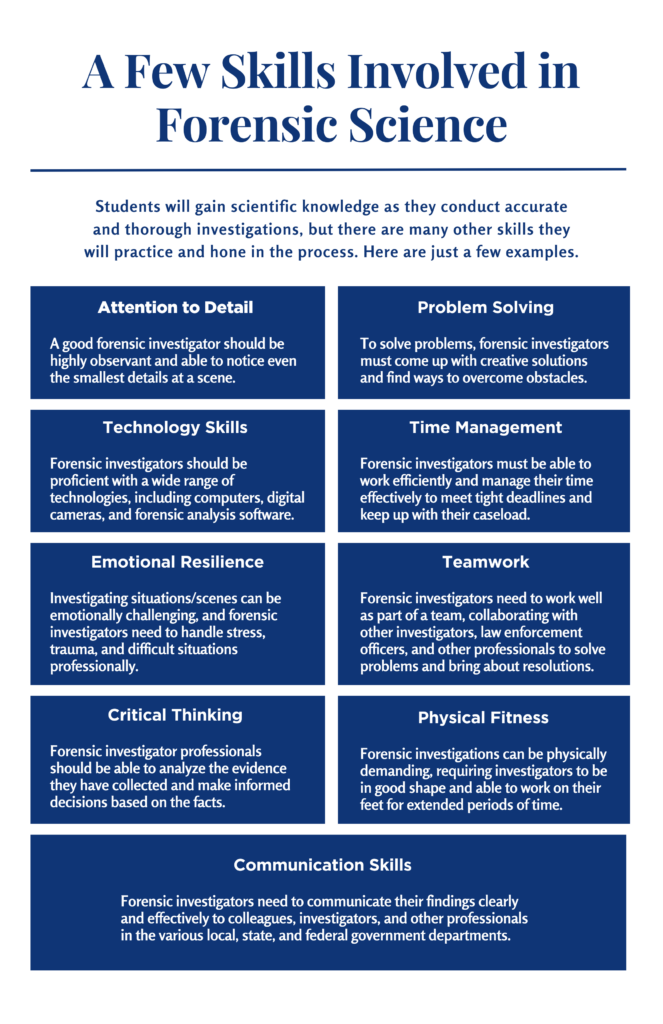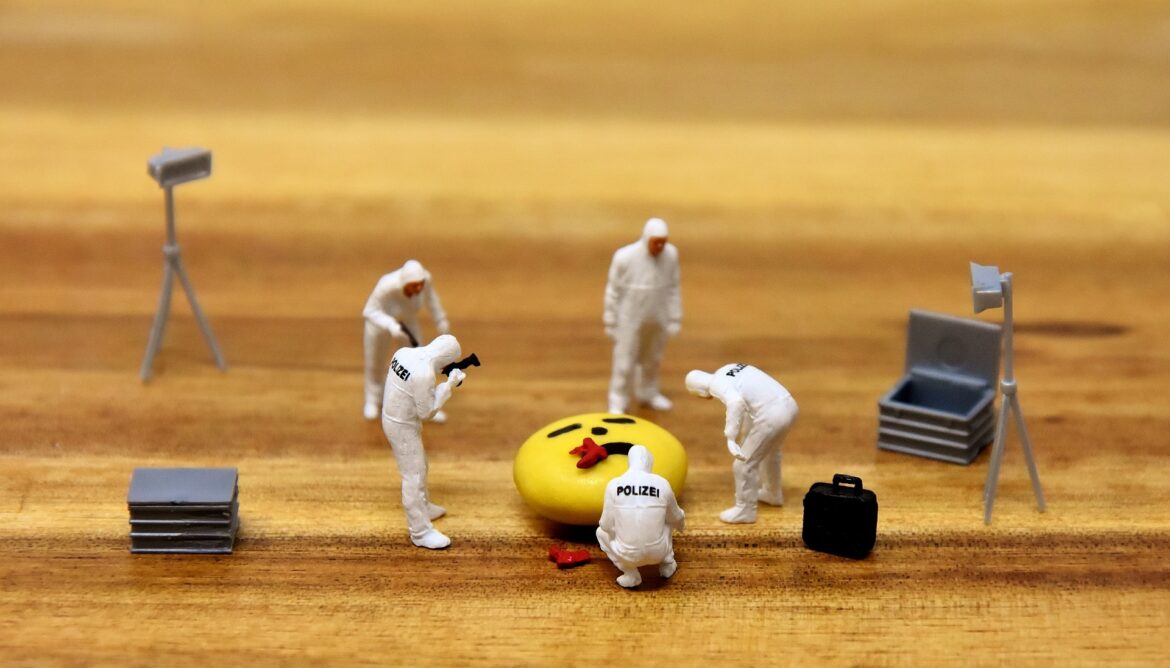If you are a science teacher, then it probably goes without saying that you enjoy science, AND you want your students to develop a love for science as well. Unfortunately, we know that some students find science unrelatable, complex, or even boring. What?! How can that be?! Whether you have one student who isn’t excited about science or a classroom full of students who haven’t caught the science bug, using forensic science techniques can be a game changer for both students and teachers.
What Is Forensic Science?
Forensic science in the classroom involves students becoming investigators who use clues and what they currently know to figure out a solution. The U.S. Department of Justice says, “Forensic scientists examine and analyze evidence from crime scenes and elsewhere to develop objective findings that can assist in the investigation and prosecution of perpetrators of crime or absolve an innocent person from suspicion.” That said, forensic science investigations may conjure up ideas of bloody crime scene investigations as played out on popular tv shows such as CSI: Crime Scene Investigation, The First 48, Cold Case Files, and the like. But you don’t have to use the crime scene context to have engaging and interesting forensic science take place in your classroom!
Skills Involved with Forensic Science

Of course, students will gain scientific knowledge as they conduct accurate and thorough investigations. But there are many other skills they will also practice and hone in the process. Here are a few examples of skills they’ll develop as they take on the role of forensic scientist in your classroom.
Attention to Detail. A good forensic investigator should be highly observant and able to notice even the smallest details at a scene.
Communication Skills. Forensic investigators need to communicate their findings clearly and effectively to colleagues, investigators, and other professionals in the various local, state, and federal government departments.
Emotional Resilience. Investigating situations/scenes can be emotionally challenging, and forensic investigators need to handle stress, trauma, and difficult situations professionally.
Critical Thinking. Forensic investigator professionals should be able to analyze the evidence they have collected and make informed decisions based on the facts.
Technology Skills. Forensic investigators should be proficient with a wide range of technologies, including computers, digital cameras, and forensic analysis software.
Physical Fitness. Forensic investigations can be physically demanding, requiring investigators to be in good shape and able to work on their feet for extended periods of time.
Problem Solving. To solve problems, forensic investigators need to be able to come up with creative solutions and find ways to overcome obstacles.
Time Management. Forensic investigators must be able to work efficiently and manage their time effectively to meet tight deadlines and keep up with their caseload.
Teamwork. Finally, forensic investigators need to work well as part of a team, collaborating with other investigators, law enforcement officers, and other professionals to solve problems and bring about resolutions.

How to Use Forensic Science in Your Classroom
For the classroom, a forensic science investigation is an interactive project during which students learn critical skills and knowledge on a particular topic. As such, you can take any concept, chapter, or unit you teach in your classroom and have it play out in a forensic investigation method. Here are a few critical components for you to think through as you adapt your content to the forensic science-based activity:
ROLES: Clearly define the role that students will play. Will different students have different roles? If so, how will their tasks depend on each other to arrive at the desired outcome?
PROBLEM(S): Write out a scenario to give students the context of the situation that they’ve been dropped in. Depending on the age of your students, you may need to clarify the problem. Consider withholding some information (or playing devil’s advocate at times) to encourage critical thinking, collaboration, and research.
OBSTACLES: Think of several “obstacles” that you can present at a few points along the way. If your investigation is to be done during one class period, you may not have time to include obstacles. These might be equivalent to the “Go to Jail” card in a game of Monopoly. Obstacles may require students to do additional research, collect additional information, or redo a portion of previous work because of ‘tainted evidence.’
EQUIPMENT: Be sure to have the equipment that students will need…or a variety of equipment for them to choose from. It might be that you let them figure out what tools/equipment they need to accomplish the various aspects of the lesson.
MODERATOR: The moderator, which is typically you, checks the students’ work at specific points before allowing them to continue. This could be somewhat facilitated by providing answer keys to a certain extent. The moderator would also be the one to hand out ‘obstacles’ to individual students or groups.
GROUPING: Consider how you will organize the students. Will they be grouped as teams with each student having a different role within the team? Will there be no groups, though different students may have common roles, giving them choice in who they work with when they need to interact with a different role than their own?
While all these components would be helpful in a full-blown forensic science lesson/unit, you can start with just a few of them. When just beginning, it would be wise to keep it simple; if you are confused and overwhelmed, then it is likely that your students will be, also.
Non-Crime Scene Examples of Incorporating Forensic Science

This process may make a lot of sense if you teach a high school course called “Forensic Science,” but what if you teach a high school biology class, a fourth grade science class, or even kindergarten? How can we use elements of forensic science in those areas?
First, begin with the student learning standards. Consider how you can create a scenario with a problem to solve; something unfortunate has happened, and your students are needed to help fix the situation. Students are given some information about the new concepts/skills but have to use different resources to figure out the rest.
Here are a few examples that may help illustrate what this can look like at different levels.
Grades K-1: A piece of luggage was found that has a variety of items in it along with the name and address of the owner. Unfortunately, you can only send back the items that float because of new airline rules. Investigate the items to identify which ones float and which ones sink. Record a clear description of each before packaging them to ship to the owner.
Grades 2-5: The solar system seems to be going crazy. You work for NASA and just received a set of photos (that are not labeled) of the planets and have been tasked with identifying the names of the planets along with critical information for each so they can be put back in their correct orbits. Be careful, though. Some planets from other solar systems may have gotten mixed in. As the top astronomer, you need to research the information to identify each photo (and its specific information), order them correctly, and then share your research (presentation) with the Head of Planetary Security (the teacher). You must act quickly before Earth is thrown out of its orbit and life ends as we know it!
Grade 6-8: Congratulations! You are the new owner of a zoo. Unfortunately, the previous zoo keeper did not keep good records. You only have small bits of information to go on, and you need to identify what animals are in your zoo so you can track them down. You must also update each animal’s habitat to provide a realistic living environment. You will also need to provide ways for the public to view the animals when they visit the zoo.
High School Biology: You work for a mad scientist who is engineering prokaryote and eukaryote cells. He fell before he could reconstruct the cells he was working with and now suffers from amnesia. You’ve been asked to step in and examine the parts of the cells and successfully reconstruct both types of cells. Whether or not his experiments can continue is up to you!
High School Chemistry: As head of the state OSHA (Occupational Safety and Health Administration) department, you have just received information about a hazardous event in a town nearby. You’ve been asked to analyze the event’s outcome and work backward to determine what chemicals could have been used to create the event. You’ll review anecdotal evidence from several eyewitnesses and investigate residue showing atomic structures. You will work with your team to identify at least one possible scenario and what could be used to reduce the likelihood of such an event happening again.
Additional Resources and Websites
If you are looking for resources that have more information on forensic investigative activities, then check out a few of these.
- 18 Hands-On Crime Scene Activities
- You Be the Crime Scene Investigator
- Lesson Plan: Crime Scene Investigation
- Idaho PBS: CSI
- Crime Scene Investigation Activities
- Crime Scene Science Lab Lessons
- The Real CSI – Forensic Science for K-12 Students (create a mock crime scene in your classroom)
- Crime Scene Investigation for Kids: Labs, Projects, CSI Mysteries, and Books
- Forensics Activities for Elementary Students
- 21 Fun Forensic Science Activities for Kids
- Forensic Activities for the First Day of School
How Will You Incorporate Forensics?
There are a lot of ways that you can incorporate forensic science into your classroom to better motivate and engage your students. How will you adapt this information to make it work for your students and the specific content that you are teaching? We’d love to hear from you. Drop a comment below to let us and others know what you are doing to help solve the case of unmotivated science students.

